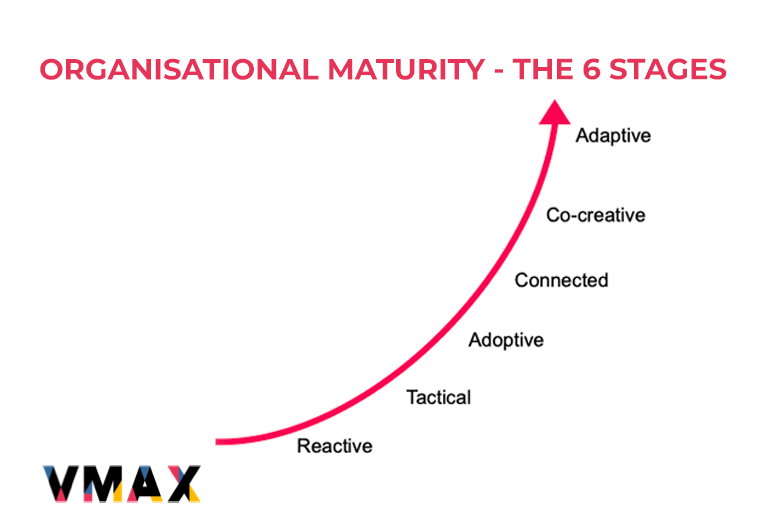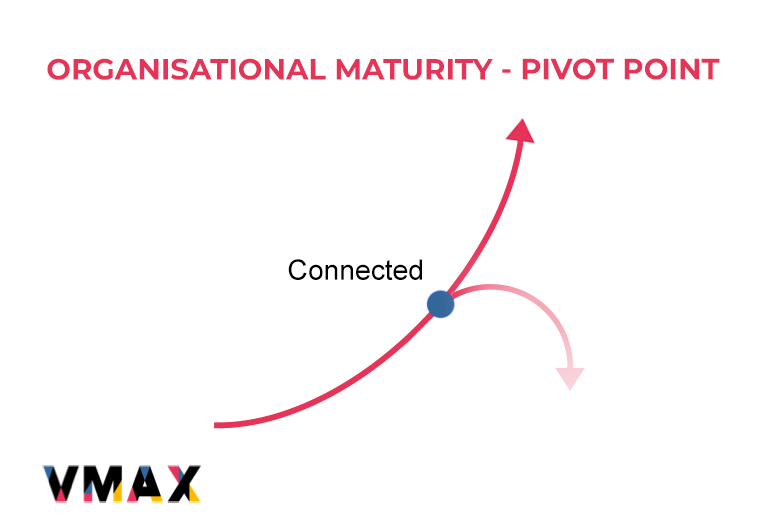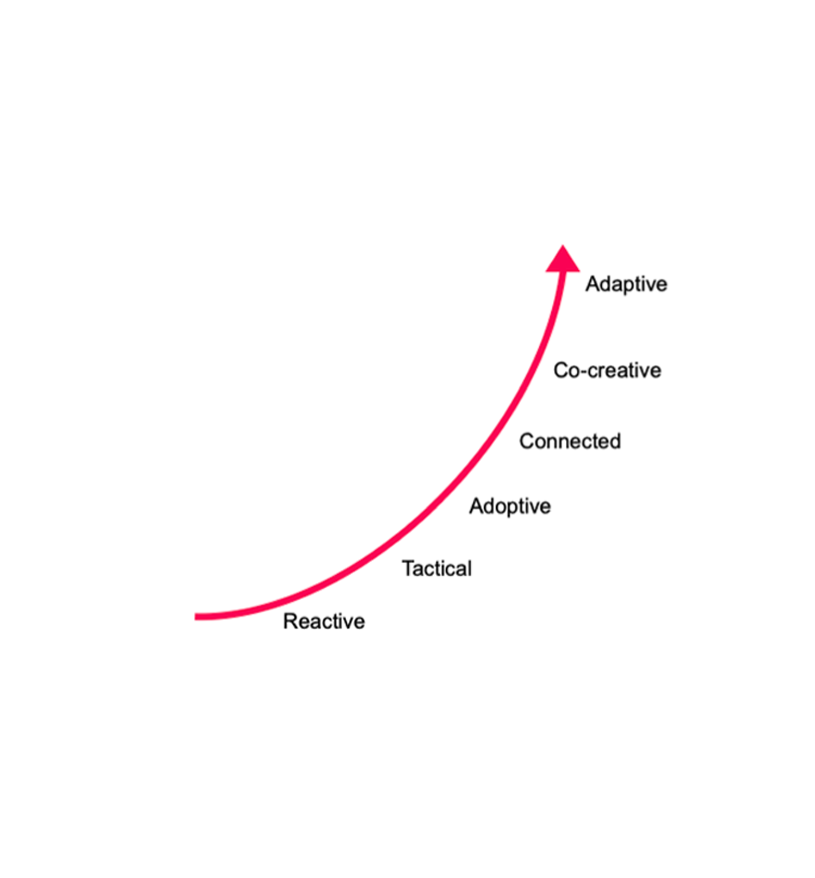In today’s dynamic and competitive business environment, the concept of organisational maturity is of paramount importance. An organisation’s maturity is not merely a measure of its age or size; instead, it encapsulates a spectrum of capabilities, strategies, and cultural attributes that determine its resilience, adaptability, and long-term success.
Organisational maturity is a journey of continuous evolution and refinement, and one that can be purposefully managed so that the organisation understands and embeds successful characteristics and uses these to create value and growth, resilience and sustainability.
From our experience and research, we observe that organisations have 6 stages of maturity, although many do not ever get close to the top end of the curve.
The diagram below shows the 6 phases and how they build towards a level of maturity that enables the organisation to rapidly and seamlessly adapt to its operating environment, shaping the market and creating sustainable growth.

REACTIVE
In this very early stage of maturity the organisation resembles a ball bearing in a game of pinball – it reacts to stimuli without fully considering cause or consequences and consequently it gets buffeted by the prevailing pressures of the moment. Early-stage organisations tend not to have the systems, processes, resources or infrastructure to plan their way forwards so push ahead with their founding vision.
The leadership focus is typically somewhere between pushing the central purpose (“we are here to sell x or to develop y so let’s all just do that”) and juggling resources to keep the lights on.
The challenge is around survival from one challenge to the next whilst the business develops the profile and market to establish and embed viability with its customers.
TACTICAL
The experience of operating in the Tactical stage informs organisation of the need for systems and processes which will enable the technical experts to work together and so in this next phase we see the adoption of best practice from experience, books, consultants, or other reputable sources of expertise. Often these processes are ‘shoe-horned’ into the organisation and there are few examples of them being coherently planned and embedded – rather they are adopted on a piecemeal basis to meet the demands of emergent issues and challenges.
The leadership focus is generally centred around ensuring compliance to the adopted systems in which there is usually a high degree of intrinsic confidence.
The challenge at this stage is that the adopted processes do not deliver their promised value return, managing compliance becomes more difficult and the organisation becomes increasingly bureaucratic.
ADOPTIVE
As organisations mature through the start-up phase, they become increasingly focused on structuring themselves along functional lines with a predominantly tactical mindset. Survival is a compelling driver, but this is accompanied by the need to bring in subject matter experts to deliver value and therefore an increased stratification of responsibilities as trust is placed in the various experts.
The leadership focus is typically centred around building and demonstrating expertise and leadership teams tend to comprise highly capable technical experts.
The challenge is around aligning the various SMEs into a coherent team that can work effectively together and share knowledge to generate new ideas and approaches.
CONNECTED
This is a pivotal stage of organisational maturity and one which many organisations do not move beyond. In this stage there is a recognition of the need to connect the various parts of the organisation into a coherent operation and to ensure that supporting systems and processes are adapted to ensure synergy and optimise value creation.

The pivot point here leads to two quite different types of connectedness:
- Early maturity connectedness is generally focused on securing operational efficiency and resolving problems that arise across the organisation. The drive to connect is to ensure that adoptive processes are adhered to and that collaboration across the points of functional interface are managed as easily as possible.
- Later maturity connectedness is focused on driving organisational performance which requires leaders to work across boundaries, to share insights and cocreate solutions, to focus on facilitation of excellence rather than demonstration of experience and, most importantly, to understand the meta levels of connectedness that exist and need to exist within the organisation and between the organisation and its environment.
In essence, where the organisation sees connectedness as an end in itself it focuses on using this stage to correct and further avoid any of the issues encountered in the earlier stages of maturity. This, then, becomes the ‘correct’ mode of operation and paradoxically, whilst this does prevent regression to the issues previously encountered, it also seriously limits the organisational ability to do anything other than achieve incremental growth.
Where, however, the organisation sees connectedness as a stage of maturity, then it connects in order to leverage value and enhance performance. This moves beyond internal connectedness to identifying and pursuing the need to connect across the marketplace, to create networks of opportunity and to explore ways of using the combined intelligence of the network in a transparent and explorative manner which build the necessary levels of trust and confidence to enable the shift to the next stage of maturity.
The leadership focus here is concerned with moving from a leader as expert to a style of enabling leadership whereby the leader facilitates and creates the opportunity and environment for the teams to succeed.
The challenge is letting go of much of the received and learned wisdom of the earlier stages and really focusing on building relationship and building trust. Managing change resistance through engagement and clear leadership is central to success with these challenges
Once the leadership team acknowledges that connectedness is a stage and not a destination, then they can really drive towards becoming a high performance organisation on the top levels of this maturity curve. This requires significant leadership skill and the development of approaches which would, at lower levels of maturity, not work effectively. The challenge is high but the benefits are huge.
Co-creative
This stage requires high degrees of trust and a genuine curiosity and willingness to engage openly with others to further shared understanding and shared capability. In this stage the organisation can truly say that it is building on the combined intelligence and capability of all of its people. People come together to explore and discover ways of working that in previous more structurally hierarchical stages would not have been possible. People co-create solutions and, in doing so, have a high degree of ownership and commitment to make them successful. The strategy needs to be clear so that people understand the boundaries within which they are empowered to operate, but within those boundaries they can utilise their unique and personal capabilities to work with colleagues and deliver value. Of course, there needs to be escalation routes where co-creative working cannot find a resolution but as the organisation matures through this phase these become less used and the quality of conversation and critical thinking increases.
The leadership focus in this phase truly progresses to enabling leadership at an enterprise level – this is leadership as a service to enable, to facilitate, to develop and to create value.
The challenge is fundamentally about confidence and trust especially in the early stages where past experience will guide the organisation to create rules and processes to ensure alignment, but which actually limit growth.
Adaptive
This is, in many ways, the natural evolution from a co-creative stage of maturity as the organisation has learnt to trust its people and have high confidence in their ability to deliver. In this stage the organisation can seamlessly and rapidly respond to changes because it can mobilise highly engaged and committed resources faster and in a more focused way than its competitors. This agility is not limited to organisational resources, because the co-creative stage has enabled the organisation to create wider networks of resource and opportunity, through which impact can be achieved and value can be created. Not only can an adaptive organisation respond to actual events, it can also respond to potential or indeed conceptual opportunities and challenges and thereby shape the market within which it operates. This shaping used to be a function of size and dominance but is increasingly nowadays a function of adaptive capability.
The leadership focus is quite evidently on providing focus and nurturing the relationships through which value is created.
The challenge is about focus – keeping the strategy in mind at all times so that adaptations are always intentional and strategically aligned.
Key drivers of organisational maturity
Whilst organisational maturity is a complex process that is in no way a linear progression, the drivers of maturity are clear.
First and foremost is mindset – having an understanding that the organisation needs to evolve; the confidence that this will be a positive and transformative experience; and an unremitting focus on transparent and generative learning
The second key driver is a clear strategy for growth that encompasses the sphere of operations for the organisation but also covers the intentional way in which organisation will progress along the maturity curve
Leadership is clearly a driver, and it is imperative to recognise the different styles of leadership required at different stages of maturity – an enabling leadership style within a tactical organisation can be as damaging as a controlling leadership style within a co-creative organisation. Developing high levels of self-awareness and capability amongst the leadership team within the overall context of enterprise leadership is vital.
Organisational culture is often described as the “set of behaviours that we tolerate here” which, whilst accurate, belies the fact that culture is a powerful tool for transformative change and, as such, needs to be purposefully managed and nurtured as a driver of organisational maturity.
At all stages of the maturity curve, people are central to success, whether as SMEs operating within their functional teams or as facilitative sources of insight and learning in a co-creative team. People development from a behavioural and attitudinal perspective to augment technical knowledge and skills is therefore a significant driver of maturity.
The final driver that is often overlooked are the supporting systems and processes which the organisation uses to deliver its strategy. These need to be aligned and compatible with the various stages of maturity otherwise they swiftly become ‘sea-anchors’ that hold back the pace of change and limit organisational effectiveness.
Organisational maturity is a multi-dimensional journey that transcends conventional metrics of success. It’s about nurturing a culture of resilience, innovation, and adaptability that propels an organisation towards sustainable growth. Embracing this journey requires commitment, visionary leadership, and an unwavering dedication to constant evolution. As organisations embark on this expedition, they unlock the potential to not just survive but to thrive in an everchanging business landscape.
The journey can and should be intentionally managed and, if so, it is a powerful strategic process to unlock and unleash the collective capability and potential of the organisation.

